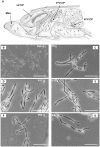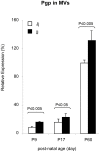Modulation of Mrp1 (ABCc1) and Pgp (ABCb1) by bilirubin at the blood-CSF and blood-brain barriers in the Gunn rat
- PMID: 21297965
- PMCID: PMC3031532
- DOI: 10.1371/journal.pone.0016165
Modulation of Mrp1 (ABCc1) and Pgp (ABCb1) by bilirubin at the blood-CSF and blood-brain barriers in the Gunn rat
Abstract
Accumulation of unconjugated bilirubin (UCB) in the brain causes bilirubin encephalopathy. Pgp (ABCb1) and Mrp1 (ABCc1), highly expressed in the blood-brain barrier (BBB) and blood-cerebrospinal fluid barrier (BCSFB) respectively, may modulate the accumulation of UCB in brain. We examined the effect of prolonged exposure to elevated concentrations of UCB on expression of the two transporters in homozygous, jaundiced (jj) Gunn rats compared to heterozygous, not jaundiced (Jj) littermates at different developmental stages (2, 9, 17 and 60 days after birth). BBB Pgp protein expression was low in both jj and Jj pups at 9 days (about 16-27% of adult values), despite the up-regulation in jj animals (2 and 1.3 fold higher than age matched Jj animals at P9 and P17-P60, respectively); Mrp1 protein expression was barely detectable. Conversely, at the BCSFB Mrp1 protein expression was rather high (60-70% of the adult values) in both jj and Jj at P2, but was markedly (50%) down-regulated in jj pups starting at P9, particularly in the 4(th) ventricle choroid plexuses: Pgp was almost undetectable. The Mrp1 protein down regulation was accompanied by a modest up-regulation of mRNA, suggesting a translational rather than a transcriptional inhibition. In vitro exposure of choroid plexus epithelial cells obtained from normal rats to UCB, also resulted in a down-regulation of Mrp1 protein. These data suggest that down-regulation of Mrp1 protein at the BSCFB, resulting from a direct effect of UCB on epithelial cells, may impact the Mrp1-mediated neuroprotective functions of the blood-cerebrospinal fluid barrier and actually potentiate UCB neurotoxicity.
Conflict of interest statement
Figures








Similar articles
-
Differential expression of the multidrug resistance-related proteins ABCb1 and ABCc1 between blood-brain interfaces.J Comp Neurol. 2008 Oct 10;510(5):497-507. doi: 10.1002/cne.21808. J Comp Neurol. 2008. PMID: 18680196
-
Molecular basis of bilirubin-induced neurotoxicity.Trends Mol Med. 2004 Feb;10(2):65-70. doi: 10.1016/j.molmed.2003.12.003. Trends Mol Med. 2004. PMID: 15102359 Review.
-
(R)-[(11)C]verapamil is selectively transported by murine and human P-glycoprotein at the blood-brain barrier, and not by MRP1 and BCRP.Nucl Med Biol. 2013 Oct;40(7):873-8. doi: 10.1016/j.nucmedbio.2013.05.012. Epub 2013 Jul 8. Nucl Med Biol. 2013. PMID: 23845421 Free PMC article.
-
Role of multidrug resistance-associated protein 1 expression in the in vitro susceptibility of rat nerve cell to unconjugated bilirubin.Neuroscience. 2007 Feb 9;144(3):878-88. doi: 10.1016/j.neuroscience.2006.10.026. Epub 2006 Dec 4. Neuroscience. 2007. PMID: 17141959
-
The role of ABC transporters in protecting cells from bilirubin toxicity.Curr Pharm Des. 2009;15(25):2884-92. doi: 10.2174/138161209789058246. Curr Pharm Des. 2009. PMID: 19754365 Review.
Cited by
-
Electroconvulsive shock attenuated microgliosis and astrogliosis in the hippocampus and ameliorated schizophrenia-like behavior of Gunn rat.J Neuroinflammation. 2016 Sep 2;13(1):230. doi: 10.1186/s12974-016-0688-2. J Neuroinflammation. 2016. PMID: 27590010 Free PMC article.
-
Histone acetylation as a new mechanism for bilirubin-induced encephalopathy in the Gunn rat.Sci Rep. 2018 Sep 12;8(1):13690. doi: 10.1038/s41598-018-32106-w. Sci Rep. 2018. PMID: 30209300 Free PMC article.
-
Barrier mechanisms in the developing brain.Front Pharmacol. 2012 Mar 29;3:46. doi: 10.3389/fphar.2012.00046. eCollection 2012. Front Pharmacol. 2012. PMID: 22479246 Free PMC article.
-
Mechanistic understanding of brain drug disposition to optimize the selection of potential neurotherapeutics in drug discovery.Pharm Res. 2014 Aug;31(8):2203-19. doi: 10.1007/s11095-014-1319-1. Epub 2014 Mar 13. Pharm Res. 2014. PMID: 24623476
-
Bilirubin-Induced Transcriptomic Imprinting in Neonatal Hyperbilirubinemia.Biology (Basel). 2023 Jun 8;12(6):834. doi: 10.3390/biology12060834. Biology (Basel). 2023. PMID: 37372119 Free PMC article.
References
-
- Gourley GR. Bilirubin metabolism and kernicterus. Adv Pediatr. 1997;44:173–229. - PubMed
-
- Ostrow JD, Pascolo L, Shapiro SM, Tiribelli C. New concepts in bilirubin encephalopathy. Eur J Clin Invest. 2003;33:988–997. - PubMed
-
- Ostrow JD. Bile pigments and jaundice. Marcel Dekker, Inc; 1987.
-
- Kaplan M, Muraca M, Hammerman C, Rubaltelli F, Vilei MT, et al. Imbalance between production and conjugation of bilirubin: a fundamental concept in the mechanism of neonatal jaundice. 2002. Available: ttp://pediatrics.org/cgi/content/full/110/4/e47. - PubMed
-
- Shapiro SM, Bhutani VK, Johnson L. Hyperbilirubinemia and kernicterus. Clin Perinatol. 2006;33:387–410. - PubMed
Publication types
MeSH terms
Substances
Grants and funding
LinkOut - more resources
Full Text Sources
Other Literature Sources
Miscellaneous

